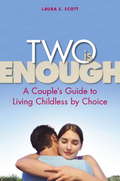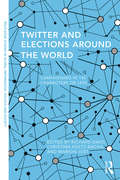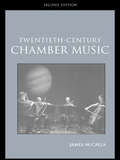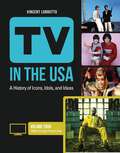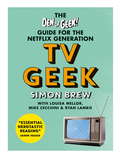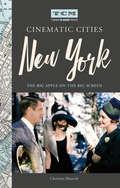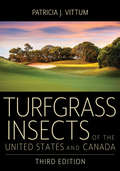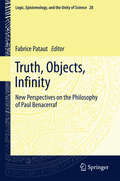- Table View
- List View
Type 3 & 4 plastic recycling symbols (UEB Contracted)
by RnibOn this page, there are two symbols from the set of resin identity codes developed by the US Society of the Plastics Industry (SPI) in 1988. They are intended to enable recyclers to sort plastic refuse easily for reprocessing. They are used internationally. There is a locator dot shown, which will be at the top left of the page when the image is the correct way up. Each symbol consists of three clockwise chasing arrows arranged in a triangular shape with the point at the top. The triangle has a print character number inside and an abbreviation for the plastic type in upper case print characters down the page. The symbol for type 3 plastic is in the top left of the page. It is labelled V for Polyvinyl chloride. The symbol for type 4 plastic is in the bottom right of the page. It is labelled LDPE for Low-density polyethylene.
Type 3 & 4 plastic recycling symbols (Large Print)
by RnibOn this page, there are two symbols from the set of resin identity codes developed by the US Society of the Plastics Industry (SPI) in 1988. They are intended to enable recyclers to sort plastic refuse easily for reprocessing. They are used internationally. There is a locator dot shown, which will be at the top left of the page when the image is the correct way up. Each symbol consists of three clockwise chasing arrows arranged in a triangular shape with the point at the top. The triangle has a print character number inside and an abbreviation for the plastic type in upper case print characters down the page. The symbol for type 3 plastic is in the top left of the page. It is labelled V for Polyvinyl chloride. The symbol for type 4 plastic is in the bottom right of the page. It is labelled LDPE for Low-density polyethylene.
Type 1 & 2 plastic recycling symbols (UEB Uncontracted)
by RnibOn this page, there are two symbols from the set of resin identity codes developed by the US Society of the Plastics Industry (SPI) in 1988. They are intended to enable recyclers to sort plastic refuse easily for reprocessing. They are used internationally. There is a locator dot shown, which will be at the top left of the page when the image is the correct way up. Each symbol consists of three clockwise chasing arrows arranged in a triangular shape with the point at the top. The triangle has a print character number inside and an abbreviation for the plastic type in upper case print characters down the page. The symbol for type 1 plastic is in the top left of the page. It is labelled PETE for Polyethylene terephthalate. The symbol for type 2 plastic is in the bottom right of the page. It is labelled HDPE for High-density polyethylene.
Type 1 & 2 plastic recycling symbols (UEB Contracted)
by RnibOn this page, there are two symbols from the set of resin identity codes developed by the US Society of the Plastics Industry (SPI) in 1988. They are intended to enable recyclers to sort plastic refuse easily for reprocessing. They are used internationally. There is a locator dot shown, which will be at the top left of the page when the image is the correct way up. Each symbol consists of three clockwise chasing arrows arranged in a triangular shape with the point at the top. The triangle has a print character number inside and an abbreviation for the plastic type in upper case print characters down the page. The symbol for type 1 plastic is in the top left of the page. It is labelled PETE for Polyethylene terephthalate. The symbol for type 2 plastic is in the bottom right of the page. It is labelled HDPE for High-density polyethylene.
Type 1 & 2 plastic recycling symbols (Large Print)
by RnibOn this page, there are two symbols from the set of resin identity codes developed by the US Society of the Plastics Industry (SPI) in 1988. They are intended to enable recyclers to sort plastic refuse easily for reprocessing. They are used internationally. There is a locator dot shown, which will be at the top left of the page when the image is the correct way up. Each symbol consists of three clockwise chasing arrows arranged in a triangular shape with the point at the top. The triangle has a print character number inside and an abbreviation for the plastic type in upper case print characters down the page. The symbol for type 1 plastic is in the top left of the page. It is labelled PETE for Polyethylene terephthalate. The symbol for type 2 plastic is in the bottom right of the page. It is labelled HDPE for High-density polyethylene.
Two Is Enough: A Couple's Guide to Living Childless by Choice
by Laura S. ScottFall in love. Get married. Have children. For most couples, marriage and children go hand in hand. And yet, the number of people choosing childlessness is on the rise. These are the childless by choice-people who have actively decided not to have children-rather than the childless by circumstance. In Two Is Enough, Laura S. Scott explores the assumptions surrounding childrearing, and explores the reasons many people are choosing to forgo this experience. Scott, founder of the Childless by Choice Project, examines the personal stories of people who have faced this decision and explores the growing trend of childlessness. Scott’s expert knowledge and analysis offer a picture of the childless by choice-who they are, why they’ve chosen to remain childless, and how they’ve had these conversations with loved ones. Honest and unapologetic, Two Is Enough recognizes the challenges of being childless in today’s society and offers suggestions on how that same society can change to make room for the childless and the childfree.
Twitter and Elections around the World: Campaigning in 140 Characters or Less
by Richard Davis Marion R. Just Christina Holtz BachaTwitter already has become an important electoral communication tool between candidates, parties and their specific constituencies. No serious candidate campaign ignores Twitter, while political party organizations utilize Twitter to communicate with partisans, reinforce supporters, and mobilize voters. Whereas much scholarship to date has focused primarily on Twitter’s political usage in the United States, there still remain many questions about the political uses and effects of Twitter in a global context. Does Twitter effect how reporters interact with candidates or even with each other? Does Twitter increase voter participation? Who is tweeting about elections? Why do people use Twitter in electoral contexts? Which type of candidate is more likely to use Twitter and why? Do parties differ in their use of Twitter, and why? Does Twitter increase candidate-voter interaction? Is Twitter shaping elections in various system contexts, and if so how? What is the influence of system context on Twitter use by parties, candidates, reporters, and voters? Eloquently combining theory and practice, established and rising scholars in the field of political communication have been brought together to provide an essential overview of the influence of Twitter on elections in a comparative perspective. Readers of this book will not only learn everything there is to know about this specific influence of Twitter, but more broadly how to approach the study of various online tools in general.
Twitter and Elections around the World: Campaigning in 140 Characters or Less (Routledge Studies In Global Information, Politics And Society Ser.)
by Richard Davis Marion R. Just Christina Holtz BachaTwitter already has become an important electoral communication tool between candidates, parties and their specific constituencies. No serious candidate campaign ignores Twitter, while political party organizations utilize Twitter to communicate with partisans, reinforce supporters, and mobilize voters. Whereas much scholarship to date has focused primarily on Twitter’s political usage in the United States, there still remain many questions about the political uses and effects of Twitter in a global context. Does Twitter effect how reporters interact with candidates or even with each other? Does Twitter increase voter participation? Who is tweeting about elections? Why do people use Twitter in electoral contexts? Which type of candidate is more likely to use Twitter and why? Do parties differ in their use of Twitter, and why? Does Twitter increase candidate-voter interaction? Is Twitter shaping elections in various system contexts, and if so how? What is the influence of system context on Twitter use by parties, candidates, reporters, and voters? Eloquently combining theory and practice, established and rising scholars in the field of political communication have been brought together to provide an essential overview of the influence of Twitter on elections in a comparative perspective. Readers of this book will not only learn everything there is to know about this specific influence of Twitter, but more broadly how to approach the study of various online tools in general.
Twentieth-Century Chamber Music
by James McCallaFirst Published in 2003. Routledge is an imprint of Taylor & Francis, an informa company.
Twentieth-Century Chamber Music
by James McCallaFirst Published in 2003. Routledge is an imprint of Taylor & Francis, an informa company.
Tweet of the Day: A Year of Britain's Birds from the Acclaimed Radio 4 Series
by Stephen Moss Brett WestwoodImagine a jazz musician, improvising on a theme. Then imagine that he is able to play half a dozen instruments - not one after another, but almost simultaneously, switching effortlessly between instruments and musical styles with hardly a pause for breath. If you can countenance that, you are halfway towards appreciating the extraordinary song of the nightingale . . .Wherever we are, there are birds. And wherever there are birds, there is birdsong. It's always a pleasure (and a relief) to hear sounds which prove the world's still spinning: whether it's the sighing of migrating redwings on a damp October night, the twitter of swallows fresh in from South Africa in April or the call of the cuckoo in May. Based on the scripts of BBC Radio 4's beloved year-long series, and distilling two lifetimes' knowledge, insight and enthusiasm into these pages, Brett Westwood and Stephen Moss take you month by month through the year, and the changing lives of our favourite birds. From peregrines swapping sea-cliffs for skyscrapers to swifts spending almost their entire lives on the wing; from charms of goldfinches to murmurations of starlings; from ptarmigans thriving in the Highland snow to the bright green parakeets thronging London's parks; this book is packed full of extraordinary insights and memorable facts. Tweet of the Day is a book for everyone who loves Britain's birds.(Illustrations © Carry Akroyd)
TV in the USA [3 volumes]: A History of Icons, Idols, and Ideas [3 volumes]
by Vincent LoBruttoThis three-volume set is a valuable resource for researching the history of American television. An encyclopedic range of information documents how television forever changed the face of media and continues to be a powerful influence on society.What are the reasons behind enduring popularity of television genres such as police crime dramas, soap operas, sitcoms, and "reality TV"? What impact has television had on the culture and morality of American life? Does television largely emulate and reflect real life and society, or vice versa? How does television's influence differ from that of other media such as newspapers and magazines, radio, movies, and the Internet? These are just a few of the questions explored in the three-volume encyclopedia TV in the USA: A History of Icons, Idols, and Ideas.This expansive set covers television from 1950 to the present day, addressing shows of all genres, well-known programs and short-lived series alike, broadcast on the traditional and cable networks. All three volumes lead off with a keynote essay regarding the technical and historical features of the decade(s) covered. Each entry on a specific show investigates the narrative, themes, and history of the program; provides comprehensive information about when the show started and ended, and why; and identifies the star players, directors, producers, and other key members of the crew of each television production. The set also features essays that explore how a particular program or type of show has influenced or reflected American society, and it includes numerous sidebars packed with interesting data, related information, and additional insights into the subject matter.
TV in the USA [3 volumes]: A History of Icons, Idols, and Ideas [3 volumes]
by Vincent LoBruttoThis three-volume set is a valuable resource for researching the history of American television. An encyclopedic range of information documents how television forever changed the face of media and continues to be a powerful influence on society.What are the reasons behind enduring popularity of television genres such as police crime dramas, soap operas, sitcoms, and "reality TV"? What impact has television had on the culture and morality of American life? Does television largely emulate and reflect real life and society, or vice versa? How does television's influence differ from that of other media such as newspapers and magazines, radio, movies, and the Internet? These are just a few of the questions explored in the three-volume encyclopedia TV in the USA: A History of Icons, Idols, and Ideas.This expansive set covers television from 1950 to the present day, addressing shows of all genres, well-known programs and short-lived series alike, broadcast on the traditional and cable networks. All three volumes lead off with a keynote essay regarding the technical and historical features of the decade(s) covered. Each entry on a specific show investigates the narrative, themes, and history of the program; provides comprehensive information about when the show started and ended, and why; and identifies the star players, directors, producers, and other key members of the crew of each television production. The set also features essays that explore how a particular program or type of show has influenced or reflected American society, and it includes numerous sidebars packed with interesting data, related information, and additional insights into the subject matter.
TV Geek: The Den of Geek Guide for the Netflix Generation
by Simon BrewEssential nerdtastic reading! - Jason IssacsFrom the author of Den of Geek, this is the ultimate, nerdy television guide for TV geeks everywhere!TV Geek recounts the fascinating stories of cult-classic series, reveals the nerdy Easter eggs hidden in TV show sets, and demonstrates the awe-inspiring power of fandom, which has even been known to raise TV series from the dead. Includes:- How the live-action Star Wars TV show fell apart- The logistics and history of the crossover episode- The underrated geeky TV shows of the 1980s- The hidden details of Game of Thrones- Five Scandinavian crime thrillers that became binge hits - The Walking Dead, and the power of fandomTV series are now as big as Hollywood movies with their big budgets, massive stars, and ever-growing audience figures! TV Geek provides an insightful look at the fascinating history, facts and anecdotes behind the greatest (and not-so-great) shows.
Turtles of the World: A Guide to Every Family
by Jeffrey E. Lovich Whit GibbonsA lavishly illustrated guide to the world's turtles that covers every family and genusTurtles of the World reveals the extraordinary diversity of these amazing reptiles. Characterized by the bony shell that acts as a shield to protect the softer body within, turtles are survivors from the time of the dinosaurs and are even more ancient in evolutionary terms than snakes and crocodilians. Of more than 350 species known today, some are highly endangered. In this beautiful guide, turtle families, subfamilies, and genera are illustrated with hundreds of color photographs. Each genus profile includes a population distribution map, a table of information, and commentary that includes notable characteristics and discussion of related species.More than 250 beautiful color photosEach profile features a distribution map, table of information, and commentaryBroad coverage includes every family and genus
Turtles of the World: A Guide to Every Family
by Jeffrey E. Lovich Whit GibbonsA lavishly illustrated guide to the world's turtles that covers every family and genusTurtles of the World reveals the extraordinary diversity of these amazing reptiles. Characterized by the bony shell that acts as a shield to protect the softer body within, turtles are survivors from the time of the dinosaurs and are even more ancient in evolutionary terms than snakes and crocodilians. Of more than 350 species known today, some are highly endangered. In this beautiful guide, turtle families, subfamilies, and genera are illustrated with hundreds of color photographs. Each genus profile includes a population distribution map, a table of information, and commentary that includes notable characteristics and discussion of related species.More than 250 beautiful color photosEach profile features a distribution map, table of information, and commentaryBroad coverage includes every family and genus
Turner Classic Movies Cinematic Cities: The Big Apple on the Big Screen (Turner Classic Movies)
by Christian BlauveltFor armchair travelers, film buffs, tourists, and city dwellers alike, Turner Classic Movies takes you on a one-of-a-kind tour of the cinematic sites of New York City.Highlighting the great films set in the Big Apple since the dawn of cinema to the present, Cinematic Cities: New York City is both a trove of information including behind-the-scenes stories and trivia, and a practical guide full of tips on where to go, eat, drink, shop, and sleep to follow along the path of your favorite films set in NYC. Organized by neighborhood and featuring photographs and illustrated maps throughout, this is a love letter to the city and a one-of-a-kind history of the movies.Featured films and locations include The Godfather, The Seven Year Itch, King Kong, North by Northwest, On the Town, West Side Story, When Harry Met Sally, the films of Woody Allen, and scores of others.
Turner Classic Movies Cinematic Cities: The Big Apple on the Big Screen (Turner Classic Movies)
by Christian Blauvelt Turner Classic MoviesFor armchair travelers, film buffs, tourists, and city dwellers alike, Turner Classic Moviestakes you on a one-of-a-kind tour of the cinematic sites of New York City.Highlighting the great films set in the Big Apple since the dawn of cinema to the present, Cinematic Cities: New York City is both a trove of information including behind-the-scenes stories and trivia, and a practical guide full of tips on where to go, eat, drink, shop, and sleep to follow along the path of your favorite films set in NYC. Organized by neighborhood and featuring photographs and illustrated maps throughout, this is a love letter to the city and a one-of-a-kind history of the movies.Featured films and locations include The Godfather, The Seven Year Itch, King Kong, North by Northwest, On the Town, West Side Story, When Harry Met Sally, the films of Woody Allen, and scores of others.
Turkish Studies in the History and Philosophy of Science (Boston Studies in the Philosophy and History of Science #244)
by Güven Güzeldere G. IrzikAs an academic discipline, the philosophy and history of science in Turkey was marked by two historical events: Hans Reichenbach's immigrating to Turkey and taking a post between 1933 and 1938 at Istanbul University prior to his tenure at UCLA, and Aydin Sayili's establishing a chair in the history of science in 1952 after having become the first student to receive a Ph.D. under George Sarton at Harvard University. Since then, both disciplines have flourished in Turkey. The present book, which contains seventeen newly commissioned articles, aims to give a rich overview of the current state of research by Turkish philosophers and historians of science. Topics covered address issues in methodology, causation, and reduction, and include philosophy of logic and physics, philosophy of psychology and language, and Ottoman science studies. The book also contains an unpublished interview with Maria Reichenbach, Hans Reichenbach's wife, which sheds new light on Reichenbach's academic and personal life in Istanbul and at UCLA.
The Turk Who Loved Apples: And Other Tales of Losing My Way Around the World
by Matt GrossWhile writing his celebrated Frugal Traveler column for the New York Times, Matt Gross began to feel hemmed in by its focus on what he thought of as "traveling on the cheap at all costs.” When his editor offered him the opportunity to do something less structured, the Getting Lost series was born, and Gross began a more immersive form of travel that allowed him to "lose his way all over the globe”—from developing-world megalopolises to venerable European capitals, from American sprawl to Asian archipelagos. And that's what the never-before-published material in The Turk Who Loved Apples is all about: breaking free of the constraints of modern travel and letting the place itself guide you. It's a variety of travel you'll love to experience vicariously through Matt Gross—and maybe even be inspired to try for yourself.
Turin Shroud: Leonardo Da Vinci
by Lynn Picknett Clive PrinceIn 1988, carbon dating of the world's most famous Christian relic revealed that it was a mediaeval or Renaissance forgery. Yet many questions remained. How could a hoaxer of 500 or more years ago have created an image that appears so astonishingly lifelike when seen in photographic negative? How was such an image formed? And who would have dared fake the Holy Shroud of Jesus? Setting out to answer these questions, Lynn Picknett and Clive Prince discovered that the faker was none other than Leonardo da Vinci, the Renaissance artist, scientist, inventor - and hoaxer - whose innovations are acknowledged to have been centuries ahead of his time. They also reconstructed Leonardo's secret technique - becoming the first ever to recreate the Shroud image.Now revised and updated, sensationally the new 2006 edition of Turin Shroud presents the long-lost hard evidence to link the Shroud of Turin directly with Leonardo da Vinci. Perhaps this is even his 'confession' to having faked Christianity's most sacred relic, which will astonish both believers and sceptics alike, and present a new challenge to historians of both art and photography.
Turfgrass Insects of the United States and Canada
by Patricia J. VittumThe first edition of this reference work became known as the bible of turfgrass entomology upon publication in 1987. It has proved invaluable to professional entomologists, commercial turf managers, and golf course superintendents and has been used widely in college extension courses. This classic of the field is now in its third edition, providing up-to-date and complete coverage of turfgrass pests in the continental United States, Hawaii, and southern Canada.This revised volume integrates all relevant research from the previous two decades. It provides expanded coverage of several pest species, including the annual bluegrass weevil, invasive crane fly species, chinch bugs, billbugs, mole crickets, and white grubs. Patricia J. Vittum also provides detailed information on the biology and ecology of all major pests and includes the most current information on conditions that favor insect development and biological control strategies pertinent to each species.This edition will include more than 100 black-and-white images, including diagrams of life cycles, sketches of morphological characteristics, and charts highlighting seasonal activity. The book also includes 72 full-color plates (more than 500 color images), showing closeup pictures of most of the key insects (adult and immature stages) and damaged turf. The reader should be able to identify most turf insects through the use of this text. It is a critical reference work that any serious turf professional should own.
Truth without Predication: The Role of Placing in the Existential There-Sentence (Palgrave Studies in Pragmatics, Language and Cognition)
by R. SzekelyThis book contains an original analysis of the existential there-sentence from a philosophical-linguistic perspective. At its core is the claim that there-sentences' form is distinct from that of ordinary subject–predicate sentences, and that this fundamental difference explains the construction's unusual grammatical and discourse properties.
Truth or Consequences: Essays in Honor of Nuel Belnap
by M. Dunn Krister SegerbergThe essays in this collection are written by students, colleagues, and friends of Nuel Belnap to honor him on his sixtieth birthday. Our original plan was to include pieces from fonner students only, but we have deviated from this ever so slightly for a variety of personal and practical reasons. Belnap's research accomplishments are numerous and well known: He has founded (together with Alan Ross Anderson) a whole branch of logic known as "relevance logic." He has made contributions of fundamental importance to the logic of questions. His work in modal logic, fonnal pragmatics, and the theory of truth has been highly influential. And the list goes on. Belnap's accomplishments as a teacher are also distinguished and well known but, by virtue of the essential privacy of the teaching relationship, not so well understood. We would like to reflect a little on what makes him such an outstanding teacher.
Truth, Objects, Infinity: New Perspectives on the Philosophy of Paul Benacerraf (Logic, Epistemology, and the Unity of Science #28)
by Fabrice PatautThis volume features essays about and by Paul Benacerraf, whose ideas have circulated in the philosophical community since the early nineteen sixties, shaping key areas in the philosophy of mathematics, the philosophy of language, the philosophy of logic, and epistemology. The book started as a workshop held in Paris at the Collège de France in May 2012 with the participation of Paul Benacerraf. The introduction addresses the methodological point of the legitimate use of so-called “Princess Margaret Premises” in drawing philosophical conclusions from Gödel’s first incompleteness theorem. The book is then divided into three sections. The first is devoted to an assessment of the improved version of the original dilemma of “Mathematical Truth” due to Hartry Field: the challenge to the platonist is now to explain the reliability of our mathematical beliefs given the very subject matter of mathematics, either pure or applied. The second addresses the issue of the ontological status of numbers: Frege’s logicism, fictionalism, structuralism, and Bourbaki’s theory of structures are called up for an appraisal of Benacerraf’s negative conclusions of “What Numbers Could Not Be.” The third is devoted to supertasks and bears witness to the unique standing of Benacerraf’s first publication: “Tasks, Super-Tasks, and Modern Eleatics” in debates on Zeno’s paradox and associated paradoxes, infinitary mathematics, and constructivism and finitism in the philosophy of mathematics.Two yet unpublished essays by Benacerraf have been included in the volume: an early version of “Mathematical Truth” from 1968 and an essay on “What Numbers Could Not Be” from the mid 1970’s. A complete chronological bibliography of Benacerraf’s work to 2016 is provided.Essays by Jody Azzouni, Paul Benacerraf, Justin Clarke-Doane, Sébastien Gandon, Brice Halimi, Jon Pérez Laraudogoitia, Mary Leng, Antonio León-Sánchez and Ana C. León-Mejía, Marco Panza, Fabrice Pataut, Philippe de Rouilhan, Andrea Sereni, and Stewart Shapiro.

